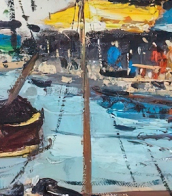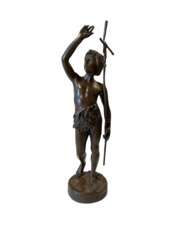shepherd&

Domenico Campagnola was an Italian painter and printmaker in engraving and woodcut of the Venetian Renaissance, but whose most influential works were his drawings of landscapes.

Giulio Campagnola was an Italian engraver, painter and miniaturist. Inventor of the original punctuation technique, which influenced the further development of European letterpress and etching.


Theo Champion was a German painter. His work was part of the painting event in the art competition at the 1928 Summer Olympics.


Giulio Campagnola was an Italian engraver, painter and miniaturist. Inventor of the original punctuation technique, which influenced the further development of European letterpress and etching.


Nicolaes Pieterszoon Berchem was a highly esteemed and prolific Dutch Golden Age painter of pastoral landscapes, populated with mythological or biblical figures, but also of a number of allegories and genre pieces.
He was a member of the second generation of "Dutch Italianate landscape" painters. These were artists who travelled to Italy, or aspired to, in order to soak up the romanticism of the country, bringing home sketchbooks full of drawings of classical ruins and pastoral imagery. His paintings, of which he produced an immense number, (Hofstede de Groot claimed around 850, although many are misattributed), were in great demand, as were his 80 etchings and 500 drawings. His landscapes, painted in the Italian style of idealized rural scenes, with hills, mountains, cliffs and trees in a golden dawn are sought after. Berchem also painted inspired and attractive human and animal figures (staffage) in works of other artists, like Allaert van Everdingen, Jan Hackaert, Gerrit Dou, Meindert Hobbema and Willem Schellinks.


Peter Paul Rubens was a distinguished Flemish Baroque painter, renowned for his dynamic, vibrant, and sensuous paintings. Born on June 28, 1577, in Siegen, Westphalia, Germany, Rubens' family moved back to Antwerp in the Spanish Netherlands (now Belgium) after his father's death. He was raised in his mother’s Roman Catholic faith and received a classical education. He began his artistic training in 1591 and later traveled to Italy, where he was profoundly influenced by Renaissance masters like Titian, Tintoretto, and Veronese. This experience significantly shaped his artistic style.
Rubens' art is celebrated for its emphasis on movement, color, and sensuality. He was particularly skilled in depicting religious and mythological scenes, portraits, and landscapes. Some of his notable works include "The Descent from the Cross" and "The Raising of the Cross," which are prime examples of Baroque religious art, showcasing his unique style that blended influences from Italian Renaissance and his own innovations.
Rubens was not just a painter but also a diplomat, serving at various European courts. He was knighted by both Philip IV of Spain and Charles I of England. His diplomatic missions often intertwined with his artistic endeavors, as seen during his travels to Spain and Italy. In addition to painting, he was involved in designing tapestries, prints, and book title-pages. He ran a large workshop in Antwerp, producing works that were popular with nobility and art collectors across Europe. His studio was in his home, the Rubenshuis, now a museum.
His influence extended to his students, notably Anthony van Dyck, and his collaborative works with other artists like Jan Brueghel the Elder. Rubens' work continued to be celebrated for its vitality and influence on the Baroque style, making him one of the most influential artists of his time.
For those interested in the work and life of Peter Paul Rubens, many of his works can be found in museums and galleries worldwide, including the National Gallery in London, which houses several of his paintings like "A View of Het Steen in the Early Morning" and "Minerva protects Pax from Mars ('Peace and War')".
To stay updated on new product sales, auction events, and more related to Peter Paul Rubens, sign up for our updates. We provide essential information tailored for collectors and experts in art and antiques, focusing on the magnificent work of Rubens and his enduring legacy in the world of art.

.jpg)
Jean-François Millet was a French artist and one of the founders of the Barbizon school in rural France. Millet is noted for his paintings of peasant farmers and can be categorized as part of the Realism art movement. Toward the end of his career, he became increasingly interested in painting pure landscapes. He is known best for his oil paintings but is also noted for his pastels, conte crayon drawings, and etchings.


Thomas Hendricksz de Keyser was a Dutch portrait painter, a dealer in Belgium bluestone and stone mason. He was the most in-demand portrait painter in the Netherlands until the 1630s, when Rembrandt van Rijn eclipsed him in popularity. Rembrandt was influenced by his work, and many of de Keyser's paintings were later falsely attributed to Rembrandt.


The Besançon illuminator was a French miniaturist painter from Besançon who worked in that city in the 1440s-1470s, decorating mainly the Books of Hours.


Arthur Hughes was an English painter and illustrator associated with the Pre-Raphaelite Brotherhood.


Winslow Homer was an American landscape painter and printmaker, renowned for his mastery of marine subjects and considered a preeminent figure in 19th-century American art. Born in Boston, Massachusetts in 1836, Homer was largely self-taught, starting his career as a commercial illustrator before venturing into oil painting and watercolors.
Homer's art evolved significantly over his lifetime. During the American Civil War, he worked as a correspondent, creating sketches that conveyed both the immediacy and the human cost of the war. This experience deeply influenced his later work, particularly his powerful oil paintings depicting war and its aftermath. After the war, Homer's focus shifted towards scenes of nature and rural America, reflecting a national nostalgia for simpler times. His works from this period, such as "The Cotton Pickers" and "Snap the Whip," showcase his ability to capture everyday life with poignant realism and emotional depth.
Later in his career, Homer became renowned for his watercolors and seascapes, such as "Breezing Up (A Fair Wind)" and "The Gulf Stream," which are celebrated for their dynamic composition and vivid portrayal of human interaction with nature. His late seascapes, which often depicted the rugged coastlines of Maine, are particularly noted for their dramatic intensity and hint at modernist abstraction, capturing the formidable power and timeless beauty of the sea.
Homer's works are held in high regard and continue to be featured in major museums and galleries, providing inspiration and insight into the American experience of the 19th century.
For those interested in the works of Winslow Homer and the impact of his art, you can sign up for updates related to new product sales and auction events featuring his work. This will keep you informed on opportunities to engage more deeply with Homer's enduring legacy.


Peter Wtewael was a distinguished Dutch Golden Age painter, known for his exquisite kitchen scenes and mythological figures. Born on June 5, 1596, in Utrecht, he was part of a notable family of artists, with his father Joachim Wtewael and brother Johan Wtewael also being recognized painters. Peter's work is characterized by its vibrant depiction of daily life and classical themes, reflecting the influence of Caravaggio in his use of dramatic lighting and realistic details.
One of Peter Wtewael's notable works, a "Kitchen Scene," is celebrated for its detailed and lively representation of a genre scene, showcasing his mastery in capturing the essence of everyday life during the Dutch Golden Age. This work, along with others, highlights his ability to intertwine erotic themes with humor and naturalistic representation, drawing parallels between the indulgence in food and carnal desires.
Peter Wtewael's contribution to art extends beyond just his paintings; his works are part of the collections of prestigious institutions like The Metropolitan Museum of Art, indicating the lasting impact of his artistic vision. His expertise in portraying both the simplicity of kitchen life and the complexity of mythological narratives has cemented his place in the history of Dutch art.
For collectors and experts in art and antiques, Peter Wtewael's paintings offer a fascinating glimpse into the Dutch Golden Age's rich tapestry of culture, history, and artistry. His legacy is preserved through his vibrant and detailed scenes, which continue to captivate and inspire audiences.
To stay informed about exhibitions, sales, and auctions related to Peter Wtewael, consider signing up for updates from art galleries and auction houses. This will ensure you have the latest information on opportunities to appreciate and perhaps acquire works by this master of the Dutch Golden Age.












































































